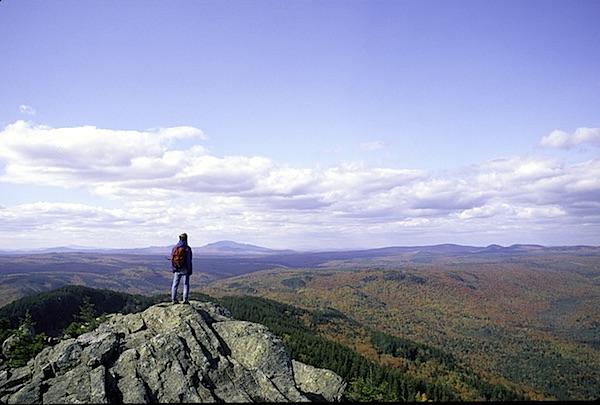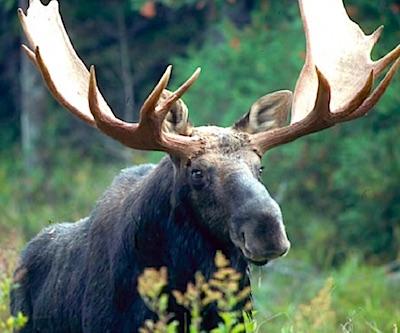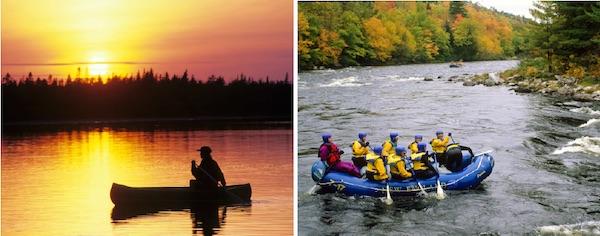
A hiker atop Borestone Mountain gazes into a potential national park in Maine/George Wuerthner
Maine isn't all rocky coastlines. Travel to the Pine Tree State's interior and you'll find a mythical, verdant, forested woodland of hemlock and balsam that inspired Henry David Thoreau's treatise, The Maine Woods.
"Every creature is better alive than dead, men and moose and pine trees, and he who understands it aright will rather preserve its life than destroy it," wrote Thoreau in expressing his concern for the future. "The mission of men there seems to be, like so many busy demons, to drive the forest out of the country.'
Under vast stands of ancient trees there are many shades of green, giant mushrooms, and mattress-soft patches of moss. The forest is so dense in places that just small shafts of sunshine penetrate and illuminate the ground, almost like spotlights. Occasionally, a moose will amble in and out of the timber, its domain embracing countless hidden lakes and streams that dot the woodlands.
The forest seems timeless.
But these woodlands have also been where families found their livelihoods for generations. They affectionately call it their 'wood basket,' where outdoorsmen, loggers, anglers, and hunters work and play. But now the woods are in conflict. Traditional users and preservationists debate the merits of a proposed national park and recreation area. The original national park proposal of the 1990s was huge; more than 3 million acres, nearly a third of Maine's Great North Woods. It envisioned one of the country's largest national parks, larger by almost a third than Yellowstone National Park. This plan was not well-received. Opponents were especially critical of millionairess Roxanne Quimby, who was donating 150,000 acres of her own lands towards a park.
Quimby is co-founder of Burt's Bees, whose honey-based lip balm and other personal care products made her a millionaire many times over. After selling the company, she has applied her wealth to conserve Maine landscapes.
But now a smaller plan is seeing more support from the locals. The current Katahdin Woods and Waters National Park and National Recreation Area proposal is just 5 percent as large as the first plan, would offer a blend of allowed activities and, according to proponents, involve less than 1 percent of the state's timber resources.
Just two hours from coastal Acadia National Park, the proposed park abuts Baxter State Park and has spectacular views of Mount Katahdin, the northern terminus of the Appalachian National Scenic Trail.
Quimby is prepared to donate 75,000 acres along the East Branch of the Penobscot River for the park, and another 75,000 acres for a national recreation area along its west bank. The national recreation area might help sooth local opinion as it could be open to hunting, fishing, and snowmobiling.
Quimby's son, Lucas St. Clair, has become its primary advocate. St. Clair is the president of Elliotsville Plantation Inc. (EPI), a company created to manage the land. (The entity's name comes from the unorganized township where Ms. Quimby first purchased lands with an eye on conservation.)

Maine's North Woods is a sanctuary for wildlife and wild lands dotted by lakes and threaded by rivers/George Wuerthner
St. Clair's grassroots approach has brought the boil back down to a simmer. He spends much of his time hunting and fishing in these very woods and discussing the proposal with proponents and opponents alike.
'We've been able to hear voices from people that are greatly affected by the outcome of this and we've been able to shape the proposal to meet the cultural and historical heritage of the region so that it really enhances what is here already as opposed to creating something that has never existed in the past,' he says.
Some opponents say the National Park Service can't manage what it already owns, and they are also wary of the federal government. During a park informational meeting in March, locals questioned the park's economics. Lincolnville resident and Friends of the Maine Woods member Andrew Young was quoted in the Bangor Daily News, as saying, 'The economic numbers do not make sense. This park will not happen. There is no money to make it happen.'
Against that view, however, St. Clair and his mother have pledged to raise a $40 million endowment for the proposed park; half would come from Ms. Quimby, and the other half from a matching campaign.
At the same time, hundreds of business owners have voiced support, saying a national park would be good for the economy as it would bolster the tourism sector and showcase a part of Maine that has been overshadowed by the state's coastal amenities and attractions.
While national park status is the nation's highest level of protection, the designation can carry some baggage. National parks may bring in tourism dollars, create jobs, and set high conservation standards, but they can also impose stricter environmental standards on surrounding industries, set restrictions on heavy recreational usage, and lure low-paying jobs.
And yet there's recognition that logging is no longer the economic stalwart it once was.
David Farmer, an EPI spokesman, concentrates upon the positive.
'It's not an either/or,' he says. 'We do not see this as competition. Industry and the national park can co-exist.'
Proponents, noting that Acadia is one of the country's top-ten visited parks, believe that a park in Maine's interior would further burnish the state's status as a tourism destination.
'An inland park would really complement the highly-toured coastline park,' says Farmer. 'This would allow tourists to move inland after a visit to Acadia for a more holistic look at the cultural, educational, and recreational experiences centered on Maine's woodland heritage.'
As mills close and young people move away in search of jobs, there's a growing sense that something needs to change for the state's economy.

From peaceful backcountry paddling destinations to thrilling whitewater adventures, Maine's North Woods offers an array of recreational opportunities/George Wuerthner
Gail Sanjoy, president of the Katahdin Chamber of Commerce, says, 'The proponents of the national park don't believe that the national park standing alone will be our area's savior, but it will go a long way from where we are today. We need to explore all options, and keep all options on the table, and the national park happens to be the offer on the table right now.'
In March the Bangor City Council voted 7-2 to support the concept of a national park, joining the towns of Millinocket, East Millinock, and the Penobscot Indian Nation. In late March, more than 200 Maine business owners sent a letter of support to their congressional delegation, which has not as yet supported the concept, choosing to listen to their constituents. But it's obvious that support is growing.
Proponents see the land and its endowment as an incredible gift at a time when economic options are limited, and feel something needs to be done. For others, these woods are their home, which contribute much more than hiking trails for the occasional tourist.
Miri Gubler spent the spring semester as an editorial intern with the Traveler. She previously has written about Acadia National Park and California condors



Comments
ec--
That isn't how our Constitution works. And you should be thankful for that.
No, it is not how our Constitution works. You and I don't have a vote in Congress. However, the National Park System is full of places that first were advocated by people like you and me and then established by the Congress.
Fully agree, but exactly what parks were established over NPS objections?
So, other than those areas created by a President using the authority of the Antiquities Act, all were created by the Congress so you must agree that the Congress has the obligation to adequately fund them. As to which parks were established over over the objections of the NPS, here's a story for you. When I worked in the Legislative Division of the NPS, I testified in front of the National Park Sub-Committee chaired by Rep. Phil Burton of California. I can't remember which area we were discussing at the moment, but I told the Committee that the area did not meet the national significance standards of the NPS. Burton peered over his glasses and responded, "Young man, the Congress of the United States will determine what is nationally significant. You just tell me how much it is going to cost."
Yes it is, but there are many places advocated by "people like you and me" that aren't in the system. Just because people like you and me advocate for them, doesn't mean they should automatically be included.
A story but no identification of a park that the NPS said "No" and Congress created anyway. Yes, Congress should fund parks it creates but the NPS should say no to parks that aren't/won't be funded.
And just how, pray tell, does the NPS say "NO" to Congress?
The Department of Defense, which is the darling of at least one side of Congress, tried to say NO to something called the F-35. What happened?
Well Lee, since none of you have come up with an example of where they said no and Congress went ahead and approved a park, I guess the answer is, the NPS can't say no.
Oh, and while there might be legitimate reasons to not want the F-35. Congress approved and FUNDED it.
Exactly my point. It's hard to say NO to the nine thousand pound gorilla. Which is probably why no one can come up with an example.
Yup. But talk about messed up priorities . . . . . .
The NPS initially opposed addition of Patterson Great Falls in New Jersey.
In fact, the Interior Department back in 2001 asked Congress not to do it until the NPS could whittle away its maintenance backlog.
/2007/10/new-jersey-delegation-unduly-forcing-great-falls-paterson-park-nps
No it is not. The Pentagon did just that. They may have not gotten their way, but at least they said "no".
One example out of 400 plus units. I see you used the term "initially". Did they change their stance? Did the unit get approved after that change?
Oh, and I kind of like the irony of your position then and now.
"If this is such a great site, why can't it stand on its own by drawing tourists without having to resort to the NPS logo and annual infusions of federal funds?"
BTW - Salazar seemed pretty delighted to have the unit when he spoke at its dedication.